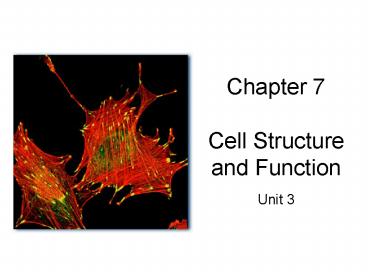Chapter 7 Cell Structure and Function - PowerPoint PPT Presentation
1 / 37
Title: Chapter 7 Cell Structure and Function
1
Chapter 7 Cell Structure and Function
- Unit 3
2
Cytology the study of cells
3
Robert Hooke
4
Robert Hooke
- Mid-1600s
- England
- Used microscope to observe living tissues
- Named chambers cells
5
Sketches from Micrographia
6
Anton van Leeuwenhoek
- Mid-1600s
- Holland
- Used hand lens microscope to observe pond water
- Observed microscopic life
7
Leeuwenhoek Microscope
8
Leeuwenhoek painting by Robert A. Thom
This painting appeared in "Great Moments in
Medicine" published by Parke Davis Company, in
1966.
9
German cell biologists
1830s Matthias Schleidan concluded all plants
made from cells
1830s Theodor Schwann concluded that all
animals made from cells
10
Rudolph Virchow
- 1855
- Germany
- New cells can only be produced from existing
cells, confirmed by French scientist Louis Pasteur
11
Pasteur painting by Robert A. Thom
This painting appeared in "Great Moments in
Medicine" published by Parke Davis Company, in
1966.
12
Lynn Margulis
- Organelles in larger, complex cells may have been
free-living prokaryotic cells in the past.
13
Cell theory
- Cells are made from preexisting cells.
- Cells are the smallest units of life.
- All living things are made from at least one cell.
Cells dividing
14
Properties of life
- Metabolism
- Homeostasis
- Growth reproduction
- Cellular basis
15
Microscopy
- the use of microscopes to study cells
- Different types of microscopes
- Light microscope
- Transmission electron microscope
- Scanning electron microscope
16
(No Transcript)
17
Light microscope
- visible light passes through specimen ? glass
lenses
Sample of light microscope image (cork)
18
Transmission electron microscope
- TEM
- studies cellular interiors
Sample of TEM image
19
Scanning electron microscope
- SEM
- studies cellular surfaces
Sample of SEM image
20
Cellular basis of life
- Multicellular organisms made up of more than one
cell - Ex protist, fungus, plant, animal
- Unicellular organisms made up of only one cell
- Ex bacteria, protist, fungus
21
To be a cell
- Plasma membrane cell membrane, made of 2 layers
of phospholipids - Cytoplasm carbohydrate and water based solution
that suspends all internal parts of the cell - Ribosomes produces proteins
- DNA genetic material made of nucleic acids
22
Two types of cells
- Prokaryote bacteria, archaebacteria
- Eukaryote protist, fungus, plant, animal
23
Prokaryotic cell
- No nucleus
- No organelles
- Small
- Simple
- Plasma membrane, ribosome, cytoplasm, DNA
24
Prokaryotic cell
- Capsule durable outer covering that some
bacteria have for protection against water,
acids, and viruses - Flagella movement
- Cell wall protective layer around plasma
membrane - Pili anchoring and DNA exchange
25
Eukaryote
- Complex
- 4 basic components organelles
- Organelles small compartments that carry out
specialized functions within a cell - Many variations
26
Cytoskeleton
27
Microtubules
- Internal support system (like mini-skeleton)
- Helps with muscle contractions
28
Smooth ER
- Endoplasmic reticulum
- produces lipids
29
Rough ER
- dotted with ribosomes, packages proteins made by
ribosomes
30
Golgi apparatus (body)
- Modify, package, and sort protein packages for
secretion, outside of cell
31
Mitochondria
- Organelle responsible for breaking down glucose
molecules into ATP energy molecules
32
Chloroplast
- Organelle in plants and algae that produces sugar
molecules by photosynthesis
33
Lysosome
- Organelle that produces enzymes to destroy
foreign molecules and waste
34
Vacuole
- Organelle that stores water, salt, food or waste
35
Nucleus
- Stores DNA
- DNA helps to regulate protein production.
- Proteins regulate cellular activity.
36
Plant Cell
Plant Cell
37
Animal Cell
Animal Cell































